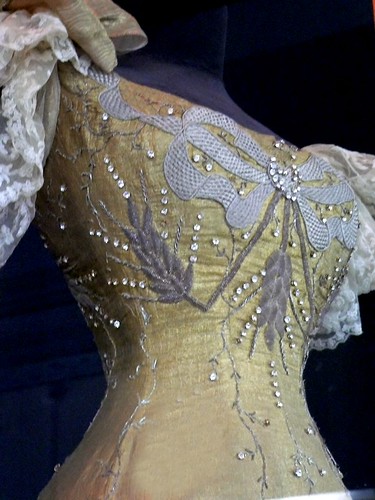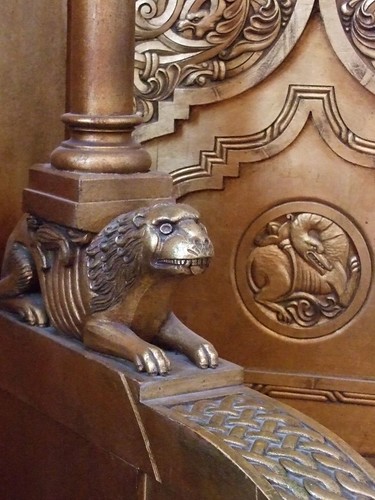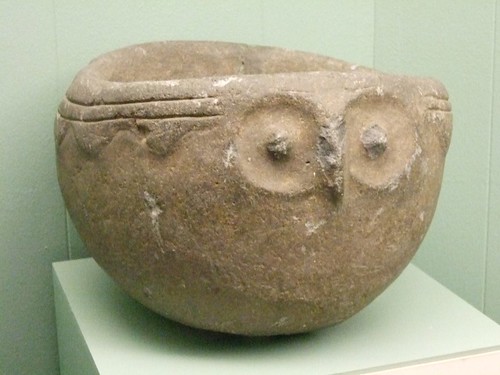 Although I have lived only five hours away from the Maryhill Museum that is across the Columbia River from The Dalles, Oregon, I didn't become one of the 10,000 visitors per month to the museum until the summer of 2006. I had heard Maryhill had a wonderful collection of European art and was home to a number of items from the estate of Queen Marie of Romania (including her coronation gown at left) but just hadn't gotten around to visiting it. Then, this past year the museum hosted a concert by the National Choir of Latvia from Riga and my sisters, brother and I decided to make the journey to Goldendale, Washington to attend the concert as a treat for our new sister-in-law from Riga. Gunta and my brother spend a month each year there and she is always anxious to share her culture with us.
Although I have lived only five hours away from the Maryhill Museum that is across the Columbia River from The Dalles, Oregon, I didn't become one of the 10,000 visitors per month to the museum until the summer of 2006. I had heard Maryhill had a wonderful collection of European art and was home to a number of items from the estate of Queen Marie of Romania (including her coronation gown at left) but just hadn't gotten around to visiting it. Then, this past year the museum hosted a concert by the National Choir of Latvia from Riga and my sisters, brother and I decided to make the journey to Goldendale, Washington to attend the concert as a treat for our new sister-in-law from Riga. Gunta and my brother spend a month each year there and she is always anxious to share her culture with us.First, a little history: Construction on the museum began in 1914 as a mansion for the wealthy entrepreneur Sam Hill.

"Samuel Hill was born to Quakers, an abolitionist physician and his wife, in North Carolina in 1857. At the end of the Civil War, the family moved to Minneapolis, Minnesota, where Hill grew up and where he attended Haverhill College. Upon graduation in 1878, Hill went to Harvard and received a second bachelor's degree in 1879.
He returned to Minneapolis and entered into a successful law practice in which he won significant verdicts against several of James J. Hill's (1838-1916) railroads (which became the Great Northern Railway). James J. Hill was so impressed with Sam's skill that he offered him a job that expanded into the presidency or directorship of a number of Hill's companies.
In 1888, Sam married James Hill's eldest daughter Mary. By the end of the nineteenth century, Sam Hill was a wealthy and accomplished railroad executive, financial manager, and investor, and he was active in a wide range of civic groups and fraternal organizations. He was noted for his tireless ambition and energy and for his integrity." - History Link.org

Sam named his estate Maryhill after his daughter, Mary. "But Hill apparently became irritated with Washington state officials for not completing a highway on the north bank of the Columbia and he abandoned the project in 1917." - History Link.org
One of Sam's friends, Loie Fuller (see a bronze of her at left by French sculptor, Theodore Louis-Auguste Riviere), an acclaimed Folies Bergere pioneer of modern dance, suggested to Sam that he convert his home into a museum, providing a cultural outpost in this rugged part of the Pacific Northwest. Using her contacts in Paris, Fuller made it possible for Sam to purchase a number of original Auguste Rodin
 sculptures to form the foundation for the new art center, including the only pedestal sized plaster version of the celebrated figure of The Thinker and a life sized plaster of Eve from the famed "Gates of Hell".
sculptures to form the foundation for the new art center, including the only pedestal sized plaster version of the celebrated figure of The Thinker and a life sized plaster of Eve from the famed "Gates of Hell".Sam traveled the world in his study and evaluation of railroads and highways and met many influential people, among them Queen Marie of Romania. During World War I, Sam extended generous support to the people of Romania. Afterwards, he invited Queen Marie of Romania to come to the United States and to dedicate his new museum when it was completed. Sadly, Sam Hill died in 1931 before it was completed. But, another friend, Alma Spreckels (of the San Francisco sugar
 company fame), having already founded the Legion of Honor Museum (the subject of another of my journeys) took up the mantle as chief benefactor of the budding Maryhill Museum. She donated many works of art from her own collection and with her guidance, the museum opened on Sam Hill's birthday, May 13, 1940.
company fame), having already founded the Legion of Honor Museum (the subject of another of my journeys) took up the mantle as chief benefactor of the budding Maryhill Museum. She donated many works of art from her own collection and with her guidance, the museum opened on Sam Hill's birthday, May 13, 1940.Upon her death, Queen Marie of Romania left a number of items from her personal estate including some uniquely beautiful Byzantine-styled furniture that she designed herself and her original audience chair. She also left her gold coronation gown and
 spectacular silver-filigreed chests and serving pieces that were given to her as wedding gifts. These items are displayed on the museum's main level along with a number of paintings from European masters.
spectacular silver-filigreed chests and serving pieces that were given to her as wedding gifts. These items are displayed on the museum's main level along with a number of paintings from European masters.The Rodin sculptures are displayed in a brightly lit gallery on the lower level along with an extensive collection of Native American baskets, clothing, and artifacts, many from the period of Lewis and Clark's Corps of Discovery expedition. Maryhill's Native American Collection began with a group of baskets acquired by Sam Hill but has grown through donations to over 800 baskets, encompassing virtually every North American basketry tradition and technical style, "from a tiny Pomo basket less than one inch in diameter to a four-foot-tall Apache storage Basket called an "olla".
"Maryhill Museum is located in the heart of the cultural region that anthropologists call the Plateau. Lying between the Rocky Mountains and the Cascade Range, the Plateau was peopled by seminomadic tribes who hunted and fished, and gathered wild roots and berries. The Plateau people were also excellent basket makers, and the Plateau collection at Maryhill is particularly noteworthy.
 Included are Wasco twined bags, twined cornhusk bags, and Klickitat and Interior Salish-style coiled baskets, as well as beaded bags and clothing, tools, utensils, toys, and games." - Maryhill Museum by Linda Brady Tesner.
Included are Wasco twined bags, twined cornhusk bags, and Klickitat and Interior Salish-style coiled baskets, as well as beaded bags and clothing, tools, utensils, toys, and games." - Maryhill Museum by Linda Brady Tesner.One of my favorite items was the 19th-century owl-shaped mortar bowl pictured at left.
Taking a brief rest, we ordered a delicious freshly-made sandwich from the small cafe Maryhill operates on the lower level. You can sit at tables provided there or take your lunch outside and enjoy the spectacular view of the Columbia River far below the bluff on which Maryhill rests.
Maryhill also houses a chess set collection with over 500 examples of the strategy game from around the world that spans hundreds of years.
 The permanent collection is the result of an exhibit originally held in 1957. The exhibit was so popular that the then-curator Clifford Dolph decided to add these miniature works of art to the museum's permanent collection.
The permanent collection is the result of an exhibit originally held in 1957. The exhibit was so popular that the then-curator Clifford Dolph decided to add these miniature works of art to the museum's permanent collection.In the upper level of the museum, Russian Orthodox icons, many from the personal collection of Queen Marie of Romania, are displayed.
"The Russian Icons in Maryhill Museum's collection, like the Queen Marie royal regalia, shed light on the life and era of Maryhill's royal benefactor and speak to a religion and culture much different from that of the average American.
 Queen Marie was the granddaughter of Tsar Alexander II; her mother, the Grand Duchess Marie and only daughter of Tsar Alexander II, married Prince Alfred of England, second son of Queen Victoria. While the marriage assured that Marie and her siblings would be raised in Victorian Great Britain and that the family would be trained in the church of England, the Russian Orthodox faith was part of Marie's life from an early age. Many of her childhood holidays were spent in Imperial Russia, where her relationships with her Romanov cousins exposed her to Orthodox rituals and religious artifacts.
Queen Marie was the granddaughter of Tsar Alexander II; her mother, the Grand Duchess Marie and only daughter of Tsar Alexander II, married Prince Alfred of England, second son of Queen Victoria. While the marriage assured that Marie and her siblings would be raised in Victorian Great Britain and that the family would be trained in the church of England, the Russian Orthodox faith was part of Marie's life from an early age. Many of her childhood holidays were spent in Imperial Russia, where her relationships with her Romanov cousins exposed her to Orthodox rituals and religious artifacts.
 Once Marie married Ferdinand, the Crown Prince of Roumania, Marie was obligated to adopt the Roumanian Orthodox faith and to promise to raise her children in the State Church. Her homes in Roumania were decorated with icons and other religious artifacts. Even in death, Marie held an icon of the Virgin.
Once Marie married Ferdinand, the Crown Prince of Roumania, Marie was obligated to adopt the Roumanian Orthodox faith and to promise to raise her children in the State Church. Her homes in Roumania were decorated with icons and other religious artifacts. Even in death, Marie held an icon of the Virgin.
In 1926 when Queen Marie ventured to the then-remote Pacific Northwest to dedicate Maryhill Museum for her friend Samuel Hill, she brought with her fifteen crates full of artwork and artifacts for the museum. Without doubt, some of the Maryhill Museum icons were in these crates.
To the Orthodox believer, these venerated objects provide a "window to heaven", a continuum which connects the secular world with the heavenly realm." - Maryhill Museum
More pictures of the objects in the permanent collection of Maryhill Museum